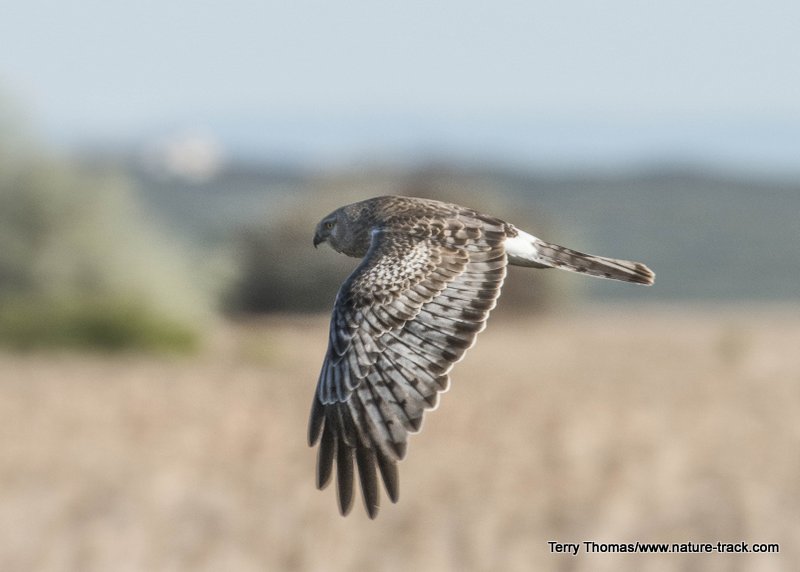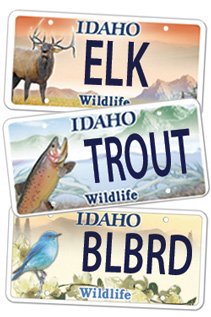Northern Harrier

A female Northern Harrier at Market Lake. The white rump patch is clearly visible.
Of all the larger hawk-sized raptors, I think I like Northern harriers the best. They are cool birds, but that isn’t why I like them. Unlike most of the hawk-like raptors, I find that harriers, as they are often called, are raptors that I can consistently identify correctly, partly because of distinguishing characteristics and behaviors and partly because they are common enough to get a good handle on them.
Without question, you have seen harriers. They are common throughout North America, Mexico and Central America and in our area, may be seen throughout the year. They are lovers of open country such as grasslands and marshes. That last one even gave them the name they were once known by, marsh hawks.
You can recognize Northern harriers by their distinctive looks and behaviors. A harrier has relatively broad wings, but sports a long narrow tail with horizontal banding. Males are gray on top and white underneath, usually with plain chest and bellies. The females and the youngsters are brown on top with whitish underparts streaked with brown. Females are larger than males. All that is good, but it is the large white spot at the base of the tail on the dorsal, or upper, side that really sets them apart. It flashes like a beacon and is unique to the harrier.
One of the most distinctive characteristics of a harrier is its face. If you get a chance to look closely, you might be surprised to discover that it resembles an owl’s face. That’s because, like owls (they are not related), harriers have disks of stiff feathers on the face that funnel sounds to their ears and help them to hear their prey. Among non-owl raptors, only the harrier depends on hearing along with keen eyes to target prey.
A dependence on hearing to help find prey leads to behavioral trait that makes harriers almost instantly recognizable. They hunt by gliding low and slow over meadows, marshes, grasslands and other open country. If there is a bit of a breeze, they may face into the wind and appear almost frozen in the air. They will often hunt within a few feet of the top of the vegetation, their wings held in a dihedral or vee configuration.
Northern harriers are mouse and vole predators first, but almost anything small is on the menu. Amphibians, reptiles and small birds are commonly taken. Sometimes harriers even go after larger prey such as rabbits and ducks and have been known to drown prey too large to easily kill with talon or beak.
When it is time to nest, both male and female harriers construct a bowl on the ground that may be two feet in diameter. The female lays and incubates 4-5 eggs while the male does most of the hunting. Males commonly support two families at the same time, but in high prey years, they have been known to support as many as five.
Harriers have been around a long time. The oldest on record was over 15-years-old, but fossil remains have been recovered in Mexico showing that these birds have been around in present form for as much as 40,000 years. With my abysmal raptor identification skill, I hope they are around a lot longer than that so I can still correctly identify a raptor on occasion.
Help Idaho Wildlife
When we traveled across the state in October 2017, we visited most of the Idaho Department of Fish and Game wildlife management areas. Most of the vehicles we saw using the wildlife management areas did not have wildlife plates. Buying wildlife plates is a great way for non-hunters and hunters alike to support wildlife-based recreation like birding.
C'mon folks, let's help Idaho's wildlife by proudly buying and displaying a wildlife license plate on each of our vehicles!
See below for information on Idaho plates. Most states have wildlife plates so if you live outside Idaho, check with your state's wildlife department or vehicle licensing division for availability of state wildlife plates where you live.
And tell them that you heard about it from Nature-track.com!

Wildlife License Plates
Great news! as of 2024, there are three NEW designs for license plates. They still are bluebird, cutthroat trout and elk, but they are beautiful.
Idaho Wildlife license plates provide essential funding that benefits the great diversity of native plants and wildlife that are not hunted, fished or trapped—over 10,000 species or 98% of Idaho’s species diversity. Game species that share the same habitats (such as elk, deer, antelope, sage-grouse, salmon, trout) also benefit from these specialty plates.
No state tax dollars are provided for wildlife diversity, conservation education and recreation programs. Neither are any revenues from the sale of hunting or fishing licenses spent on nongame species. Instead, these species depend on direct donations, federal grants, fundraising initiatives—and the Idaho Wildlife license plates.
Both my vehicles have Bluebird Plates. I prefer the bluebird because the nongame program gets 70 percent of the money from bluebird plates, but only 60 percent of the money from elk and trout plates - 10 percent of the money from elk plates supports wildlife disease monitoring and testing programs (to benefit the livestock industry) and 10 percent from cutthroat plates supports non-motorized boat access.
Incidentally, in 2014, the Idaho Legislature denied the Department of Fish and Game the ability to add new plates or even to change the name of the elk and cutthroat plates (very specific) to wildlife and fish plates, a move that would have allowed for changing images occasionally and generating more revenue. It would seem that they believe that we Idahoans don't want a well funded wildlife program.
I think it is time we let the Legislature know that Idahoan support wildlife funding and that we would like to see these generic plates come to fruition.

"WOW. What a phenomenal piece you wrote. You are amazing." Jennifer Jackson
That is embarrassing, but actually a fairly typical response to my nature essays. Since The Best of Nature is created from the very best of 16 years of these nature essays published weekly in the Idaho Falls Post Register (online readership 70,000), it is a fine read. It covers a wide variety of topics including humorous glimpses of nature, philosophy, natural history, and conservation. Readers praise the style, breadth of subject matter and my ability to communicate complex and emotional topics in a relaxed and understandable manner.
Everyone can find something to love in this book. From teenagers to octogenarians, from the coffee shop to the school room, these nature essays are widely read and enjoyed.
Some of the essays here are my personal favorites, others seemed to strike a chord with readers. Most have an important message or lesson that will resonate with you. They are written with a goal to simultaneously entertain and educate about the wonderful workings of nature. Some will make you laugh out loud and others will bring a tear to the eye and warm your heart.
Readers Write:
"You hit a home run with your article on, Big Questions in Nature. It should be required reading for everyone who has lost touch with nature...great job!" Joe Chapman
"We enjoyed your column, Bloom Where Planted. Some of the best writing yet. The Post Register is fortunate to have your weekly columns." Lou Griffin.
To read more and to order a copy, click here or get the Kindle version
Copies are also available at:
Post Register
Island Park Builders Supply (upstairs)
Barnes and Noble in Idaho Falls
Harriman State Park, Island Park
Museum of Idaho
Valley Books, Jackson Wyoming
Avocet Corner Bookstore, Bear River National Wildlife Refuge, Brigham City, Utah
Craters of the Moon National Monument Bookstore, Arco, Idaho
Wildlife License Plates
Great news! as of 2024, there are three NEW designs for license plates. They still are bluebird, cutthroat trout and elk, but they are beautiful.
Idaho Wildlife license plates provide essential funding that benefits the great diversity of native plants and wildlife that are not hunted, fished or trapped—over 10,000 species or 98% of Idaho’s species diversity. Game species that share the same habitats (such as elk, deer, antelope, sage-grouse, salmon, trout) also benefit from these specialty plates.
No state tax dollars are provided for wildlife diversity, conservation education and recreation programs. Neither are any revenues from the sale of hunting or fishing licenses spent on nongame species. Instead, these species depend on direct donations, federal grants, fundraising initiatives—and the Idaho Wildlife license plates.
Both my vehicles have Bluebird Plates. I prefer the bluebird because the nongame program gets 70 percent of the money from bluebird plates, but only 60 percent of the money from elk and trout plates - 10 percent of the money from elk plates supports wildlife disease monitoring and testing programs (to benefit the livestock industry) and 10 percent from cutthroat plates supports non-motorized boat access.
Incidentally, in 2014, the Idaho Legislature denied the Department of Fish and Game the ability to add new plates or even to change the name of the elk and cutthroat plates (very specific) to wildlife and fish plates, a move that would have allowed for changing images occasionally and generating more revenue. It would seem that they believe that we Idahoans don't want a well funded wildlife program.
I think it is time we let the Legislature know that Idahoan support wildlife funding and that we would like to see these generic plates come to fruition.